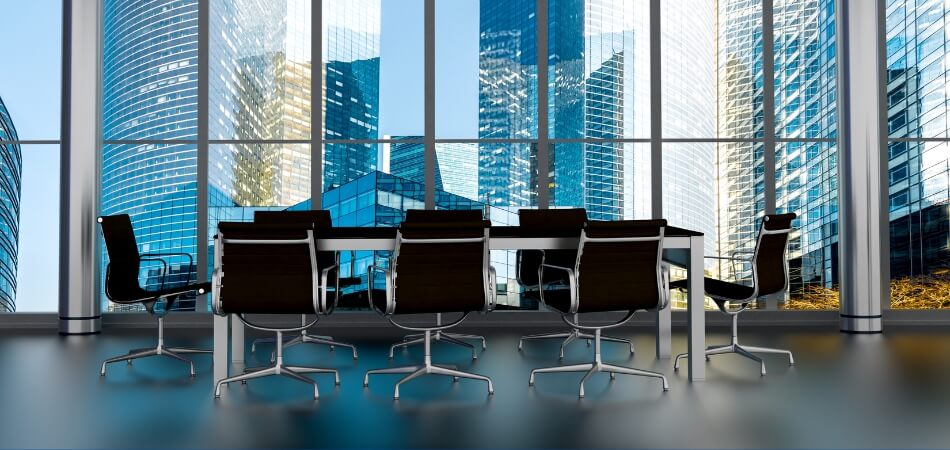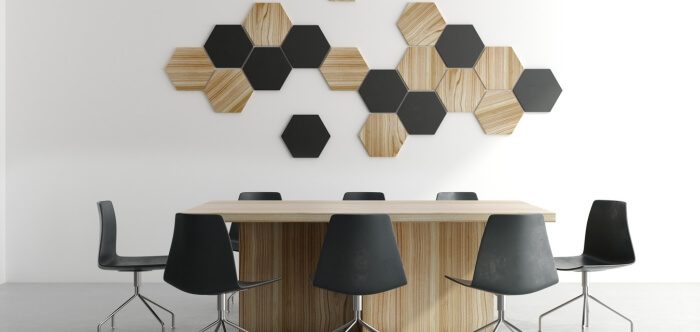Choosing the right color for a conference room can significantly impact the productivity and mood of your meetings. As we delve into the world of color psychology, it’s fascinating to see how different hues influence our work environment. For instance, vibrant shades of green not only energize a space but also help in maintaining focus, especially in brainstorming sessions. On the other hand, a light yellow can act as a natural mood booster, infusing positivity into your meeting rooms. But what color is best for a conference room?
Surprisingly, the color orange might hold the answer. Known for creating a lively, warm, and calming atmosphere, orange leaves a lasting impression, making it an excellent choice for spaces where creativity and collaboration are key.
Let’s explore how these colors can transform your conference room into a more productive and inspiring environment.
What is Color Psychology?
Color psychology is a fascinating field that explores how colors influence human behavior and emotions. By understanding the psychological effects of different hues, we can harness their power in various aspects of life, from personal spaces to marketing strategies.

At its core, color psychology studies the emotional and psychological responses that different colors evoke in people. These responses can range from feelings of calmness and relaxation to excitement and energy. For instance, blue is often associated with tranquility and stability, making it a popular choice for bedrooms and offices.
In contrast, colors like red can stimulate and energize, often used in environments where action and alertness are desired. This branch of psychology is particularly useful in marketing, where color choices can significantly influence consumer behavior and brand perception, demonstrating the profound impact colors have on our daily lives.
What Color is Best for a Conference Room?
Selecting the right color for a conference room is more than just a matter of aesthetics; it’s about setting the right tone for meetings and discussions. That’s why people often ask, “What color is best for a conference room?” Colors can significantly influence the mood and productivity of those using the space. Designing an inviting and effective conference room environment starts with understanding the psychological impact of color.
Blue: Calm and Focused
Blue is widely recognized for its calming effects, making it ideal for a conference room setting. A blue-toned room can reduce stress and create a serene atmosphere, conducive to open communication and thoughtful discussion, which is the main consideration of any event organization company. This promotes focus and clarity, essential for productive meetings.
In deeper shades, blue also conveys professionalism and trustworthiness. This makes it a popular choice for businesses that want to foster a sense of stability and reliability in their meeting spaces. A blue conference room can help in maintaining a balanced and calm environment, even during intense discussions.
Green: Balanced and Creative
Green, especially in its softer shades, is excellent for sparking creativity and balance. It’s soothing and can reduce eye strain, which is beneficial during long meetings. This color is associated with growth and renewal, inspiring fresh ideas and perspectives.
Darker shades of green can add a sense of sophistication and depth to a conference room. They create an atmosphere that encourages concentration and focus, ideal for strategy sessions and brainstorming. Green is a versatile color that can adapt to various meeting purposes, from creative workshops to formal presentations.
Yellow: Energetic and Optimistic
A light yellow can invigorate a conference room with its bright and cheerful vibe. It stimulates mental activity and generates a positive, energetic atmosphere. This color is perfect for spaces where innovation and enthusiasm are the goals.
However, use yellow in moderation, as overly bright shades can be overwhelming. Subtle yellow accents or softer tones can effectively uplift the mood without causing distraction. Yellow works well in creative agencies and start-ups, where high energy and optimism are key.
The best color for a conference room depends on the type of atmosphere you want to create. Selecting the most suitable color is one of the key items for a conference room. Whether it’s the calming influence of blue, the balanced creativity of green, or the energetic optimism of yellow, the right color can significantly enhance the functionality and mood of the space. Consider the psychological impact of colors and how they align with the goals of your meetings and discussions.
Basics of Color Theory
Color theory is an essential framework in visual arts, guiding the use of color in creating aesthetic harmony. It’s grounded in the color wheel and the relationships between colors. Understanding these basics is fundamental for artists and designers alike.
The Color Wheel
The color wheel is a circular diagram that illustrates the relationships between colors. It’s a visual representation of primary, secondary, and tertiary colors. The color wheel serves as a tool for understanding color harmony and contrast.
Understanding Hue, Tint, and Shade
Hue refers to the pure, base colors seen on the color wheel. Tint is created by adding white to a hue, lightening it. Shade is formed by adding black to a hue, and darkening it.
Primary, Secondary, and Tertiary Colors
Primary colors are red, yellow, and blue – the basis of all other hues. By mixing primary colors, we get secondary colors: orange, green, and purple. Tertiary colors are combinations of primary and secondary hues.
Warm and Cool Colors
Warm colors, like red, orange, and yellow, evoke warmth and energy. Cool colors, such as blue, green, and purple, are calming and soothing. This distinction influences color choice in design and art.
Saturated and Desaturated Colors
Saturated colors are intense and vivid, lacking any addition of white, black, or gray. Desaturated colors, having been muted with gray, appear softer and more subdued. The level of saturation can alter the mood of a composition.
Before you decide what is the best color for a conference room, it’s great to learn the basics of color theory. By understanding these principles, artists, and designers can create visually compelling and emotionally resonant works.
Choosing the Best Color for A Conference Room
Selecting the ideal color for a conference room involves more than just aesthetic preferences. It’s about creating an environment that enhances productivity and communicates the right message. The right color choice can significantly impact the effectiveness of meetings and the overall ambiance of the space.
Professionalism & Neutrality
Neutral colors like beige, gray, or light brown create a professional and unobtrusive backdrop. A few examples of standard backdrop size for a conference are 6.5ft×10ft, 8ft×10ft, and 10ft×10ft (Width×Height) and they are sufficient for regular sessions. These hues are versatile, allowing for various furniture styles and art pieces. Neutral colors also help in maintaining focus and avoiding distractions during meetings.
Accent Wall or Feature Lighting as an Option
Consider adding an accent wall for a touch of color without overwhelming the space. Pairing this with feature lighting can highlight the wall and add depth to the room. This approach allows for a subtle introduction of color while maintaining a professional atmosphere.
Taking Natural Light Into Consideration
The amount of natural light a room receives can greatly influence how a color looks. Lighter colors work well in rooms with less natural light, making the space feel brighter and larger. In well-lit rooms, darker colors can add richness and depth without making the space feel cramped.
Bold or Bright Colors to Stimulate Productivity
Bright colors like orange or yellow can stimulate creativity and energy. These are ideal for creative industries or brainstorming spaces. However, it’s important to balance these with neutral tones to avoid visual fatigue.
Power of Blue in Office Spaces
Blue is a universally appealing color that promotes calmness and focus. It’s especially effective in office environments, encouraging productivity and a sense of tranquility. Darker shades of blue convey professionalism, while lighter blues create a more relaxed atmosphere.
Choosing the best color for a conference room is a strategic decision that impacts the mood and productivity of those using the space. Whether opting for neutral tones for a professional feel, incorporating bold colors for creativity, or utilizing the calming effects of blue, the key is to create a balanced environment that serves the room’s purpose. Always consider the room’s lighting and use color to enhance the overall functionality and aesthetic of your conference room.
Factors to Consider When Selecting Paint Colors for Your Conference Room
Selecting the ideal paint hue when designing conference room settings is paramount. It plays a key role in cultivating an ambiance that enables seamless communication and heightened productivity. This color choice ought to resonate with the room’s intended function and align harmoniously with the company’s branding, all the while ensuring visual appeal. Here are key factors to consider in making this important decision:
- Room Size and Dimensions: Lighter colors make a small room appear larger and more open. Darker colors can add depth and character to a larger space.
- Natural Lighting: In rooms with ample natural light, darker colors work well without overpowering the space. Rooms with limited light benefit from lighter, reflective colors.
- Company Branding: Choose colors that align with your company’s branding and logo. This consistency reinforces brand identity and professionalism in the workspace.
- Purpose of the Room: Vibrant colors foster creativity and are suitable for brainstorming spaces. Neutral tones are better for formal meeting areas.
- Furniture and Decor: Consider existing furniture and decor the color should complement these elements. This creates a cohesive and harmonious design throughout the room.
- Psychological Impact: Colors like blue and green promote calmness and focus, ideal for serious discussions. Bright colors like yellow stimulate energy and creativity.
Selecting the right paint color for your conference room involves careful consideration of various factors including room size, natural lighting, brand identity, the intended purpose of the room, existing decor, and the psychological effects of colors. A well-chosen color scheme not only enhances the aesthetics of the room but also supports the functionality and overall atmosphere conducive to productive meetings.
Frequently Asked Questions
Choosing the right color for a conference room is essential, as it can significantly impact mood, productivity, and creativity. In this FAQ section, we will address common questions about color selection and its effects on the environment. Understanding these aspects will help you create a space that fosters collaboration and effective communication during meetings and presentations. Let’s explore the best color choices for conference rooms and their benefits!
How do you make a conference room look nice?
A visually appealing conference room can make a big impression. Start by decluttering and ensuring the space is clean and organized. Add a touch of personality with plants, artwork, or company branding. Consider the lighting and acoustics, and use soft furnishings like rugs or curtains to create a warm and inviting atmosphere. Remember, a well-designed conference room can enhance productivity and leave a lasting impression on visitors.
What makes a great conference room?
A great conference room is more than just a space for meetings. It’s a place where ideas are shared, collaborations are formed, and decisions are made. To be truly exceptional, a conference room should be comfortable, functional, and inspiring. It’s a place where people feel welcome, engaged, and motivated to succeed.
How do you design a conference room?
Designing a conference room is like creating a stage for your ideas. Consider the room’s purpose, size, and the needs of your attendees. Choose furniture that’s comfortable and conducive to collaboration. Pay attention to lighting, acoustics, and technology. And don’t forget to add a touch of personality to make the space inviting and inspiring.
How can I make my conference attractive?
A captivating conference is like a magnet for attendees. To make yours irresistible, offer a compelling agenda, feature renowned speakers, and create a memorable experience. Networking opportunities, engaging activities, and a touch of creativity can set your conference apart and leave a lasting impression. Remember, a successful conference is more than just a meeting; it’s an event that people will talk about.
How can I make my room more welcoming?
A welcoming room is like a warm hug on a cold day. To make yours inviting, start by decluttering and adding personal touches. Soft furnishings, cozy lighting, and a splash of color can create a cozy and inviting atmosphere. Remember, a welcoming space is one where you feel comfortable and at ease.
Final Thoughts
Determining “What color is best for a conference room?” requires a holistic approach that considers various elements. The ideal color choice should harmonize with the room’s size, natural lighting, and existing decor while aligning with the company’s branding and the intended purpose of the room.
Whether opting for calming blues, balanced greens, energizing yellows, or professional neutrals, the decision should enhance productivity and foster the desired atmosphere for meetings and discussions.
So, the best color choice is one that not only looks aesthetically pleasing but also positively influences the mood, focus, and creativity of those using the space, making every meeting more effective and engaging.







